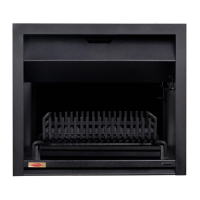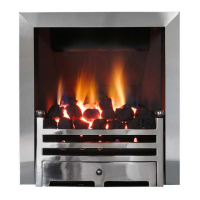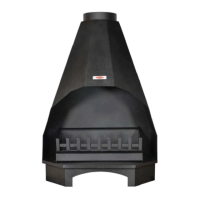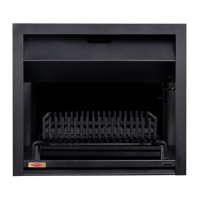Recommended Fuel Types
1. Solid Mineral Fuels and Smokeless Fuels
Solid mineral fuels and open fire smokeless fuels may be burned in basket grates or in the
controlled burning grates. Use smaller lumps and some slack when banking down for longer
periods of unattended burning. Grade 2 Housecoal is recommended more tarry coals will need
more frequent stoking.
Of the smokeless fuels, Coalite and Homefire are particularly suitable. Anthracite, closed stove
or furnace fuels and petroleum based solid fuels should not be used in Jetmaster open fires.
2. Wood
Wood has about half the calorific value of coal, on a weight for weight basis. “Green” wood has
a high moisture content, which makes it difficult to burn, and reduces net heat output.
Buying a load of green firewood means you may have been buying as much water as you are
wood. When wood is burned, the water content is converted into steam. The large amount of
heat necessary to do this accounts for the reduction in useful heat. Air-drying, or seasoning,
reduces moisture content, thus making it easier to burn. Where green wood must be burned,
first build to a strong heat to ensure that enough excess heat is produced to dispose of the
moisture.
The readiness of wood to burn depends on the density and the size of each piece. Denser
hardwoods are generally better than softwoods such as pine, which when dry burn fast and split.
A split log will catch and burn better than a full round log. Only well seasoned wood should be
used. This also helps to burn off more of the tars, and to reduce the build up of tar deposits.
The fire burning rate can thus be controlled by the amount of fuel that is used the size of fuel
and the refuelling interval. Kindling wood will burn fast, split logs at a medium rate and whole
logs a little slower. So by mixing the sizes that are burnt and used in conjunction with the throat
restrictor the fire rate of burn and hence output can be controlled.
Any of the dense hardwoods are recommended such as:- Birch, Beech, Hornbeam, Oak, Ash,
Elm and numerous others not mentioned.
3. Peat (Not tested under conditions of EN13229)
Burns gently and should be slightly damp. A mixture of dry wood with the peat is particularly
effective in the wood-burning tray. In basket grates, mix with solid fuel. Peat should NOT be
used in controlled draught grates
4. Gas (Not tested under conditions of EN13229)
Some models are suitable for use with gas fuel effect inserts.
Low models and some older versions of the wood and coal convector box are not suitable for
gas conversions.
If a Jetmaster gas conversion kit is ever fitted in the firebox the damper or throat restrictor should
be removed. If removal is not possible, it must be permanently secured in the open position.
This must be in line with the Gas safety (Installation & Use) Regulations 1998.
Fire Screens
Lighted fires should always be left with a fire screen fitted, even if you only leave the room for a
few minutes. Every Jetmaster is supplied with a fire screen, which clips to the fire.
The fire screen will become hot and care should be taken when removing the fire screen from
an operational fire, as the fire screen handles may be hot.
The feet and base of the fire screen may get hot and could burn carpets and any combustible
floor covering. Always ensure that the fire screen is stood on a non-combustible surface (The
hearth).
22
